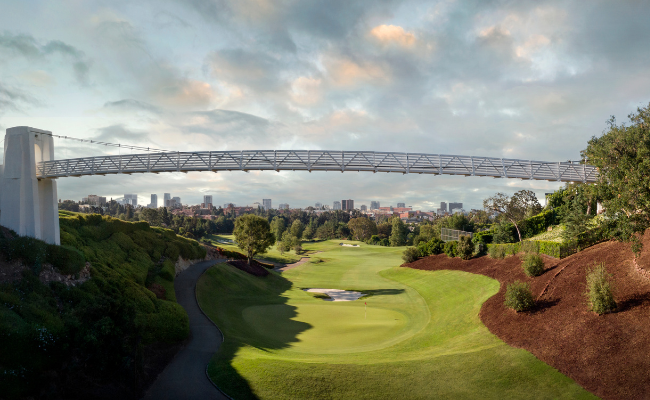This August, historic Bel-Air CC in Los Angeles will play host to the U.S. Women’s Amateur Championship. Among the trio of original USGA championships — alongside the U.S. Amateur and U.S. Open — the Women’s Am is the foundation of women’s competitive golf in the nation, dating back to 1895.
The announcement of Bel-Air’s hosting came in the spring of 2021, concurrent with the USGA news that the club will also be hosting the Curtis Cup Match in 2026 and the U.S. Mid-Amateur Championship in 2030.
Debuted in 1926, Bel-Air’s singular setting amid the Hollywood Hills is as revered for its rolling topography as a rolling good time. Bookended chronologically by LACC and Riviera CC, Bel-Air dates mid-trifecta in L.A.’s Golden Age designs from architect George C. Thomas.
As the club nears a centennial of play, the course is as renowned for its routing ingenuity as it is for the celebrity of those traversing the iconic fairways. From its beginnings, the grounds have served as stage for L.A. lore.
This is where Johnny Weissmuller set the scene or several of his Tarzan films and where Howard Hughes, as remembered in Martin Scorsese’s The Aviator, famously landed his plane on the grounds’ eighth fairway during his courtship of Katharine Hepburn.
Over time, Bel-Air’s membership has included politicians and power players the likes of Richard Nixon, Ronald Reagan and Hughes; jocks and sportsmen such as Jerry West, Wayne Gretzky, Vin Scully and Pete Sampras; and a silver screen cast of Clark Gable, Humphrey Bogart, Fred Astaire, Spencer Tracy, Jack Nicholson, Tom Cruise, Clint Eastwood and Joe Pesci.
Not that chest-puffing has ever been part of the Bel-Air scorecard.
“Golf clubs, whether here in L.A. or all over the country, have their own personality,” says Dave Podas, Bel-Air’s director of golf since 2003. “Bel-Air is no different. We’re a club of characters with character; a very eclectic group from all walks of life, many different disciplines. We like to say that when people come here, they check their ego at the door; they love to play golf and enjoy each other’s company. It was established here well before my time, but there’s a perfect balance between having a great time and respecting the game.”
Such respect is required to tackle the Thomas test, which has long belied its measured distance, tipping at 6,800 yards.
“It is hard; a wonderful test,” continues Podas. “The course looks easier on paper than when you play. The yardage isn’t intimidating, it isn’t a title fight course that’s going to beat you over the head. But it does require that you hit some golf shots, and it’s easy to make bogeys.”
An engineering feat in its day — or any day — the course is routed through four canyons. The round takes players through a series of tunnels, and includes multiple elevator trips. The turn transitions to the latter nine’s famed “Swinging Bridge,” measuring 350 feet in length and set across a crevasse on the intimidating, 205-yard, uphill par-3 10th. In 2015, the bridge was dedicated to Bel-Air’s renowned Eddie Merrins, the flat-capped “Lil’ Pro” and SoCal Golf Hall of Famer from whom Podas took the baton after Merrins served as the club’s head golf professional from 1962-2003, and who now maintains the title of Pro Emeritus.
Across the chapters of both Merrins and Podas, the grounds have seen ample architecture tinkerings of the original design with the likes of Dick Wilson, Robert Trent Jones II and multiple Fazios (George and Tom) having had their respective hands in alterations.
Restoring the Original
Yet, in 2018, a full course restoration by Tom Doak brought the course back to the original design intentions of Thomas, including the removal of myriad trees and approximately 30 bunkers that had been added over time.
“I believe it did improve the course quite a bit,” says Podas. “I think one of the reasons Tom Doak was so appealing for the restoration is because he untangled a lot of the little things that had been toyed with over the years, taking it back to the original Thomas layout. I’m paraphrasing, but Doak said something to me like, ‘The greatest compliment I can be given is if nobody even knew I was here.’”
Come late summer, however, the world will indeed know where the best women’s amateurs are swinging. While Bel-Air isn’t a total stranger to USGA play — having hosted the U.S. Am in 1976, the U.S. Senior Am in 2004 and played co-host with Riv to the stroke-play portion of the U.S. Am in ’18 — the August event and its five days of match play on The Golf Channel will showcase the grounds to an audience anew.
For those unfamiliar, get ready for some serious sand.
“The bunkering here is majestic,” Podas details. “I get calls on a weekly basis from golf course architecture aficionados who want to come out here and study our bunkering.”
And for those more familiar: Get prepped for a setup sure to usurp the challenge of daily member play. Additionally, expect the 345-yard par-4 12th to be made drivable in distance and, according to the USGA, anticipate the long, par-4 17th (475 yards) to be played as a par-5, extending the card to a par-71.
With a luminary list of past champions running from Patty Berg and SoCal Golf Hall of Famer Babe Didrikson Zaharias to Juli Inkster, Danielle Kang and Lydia Ko, the U.S. Women’s Amateur at Bel-Air looks to crown a worthy winner coming down the home stretch.
“We’re very excited, and one of the reasons I’m so personally enthused is because our second nine lays out wonderfully for match play,” concludes Podas. “It’s a great nine holes for the format because so many things can happen. I’m really excited to see how the finest women amateurs in the world navigate around our back nine.”




